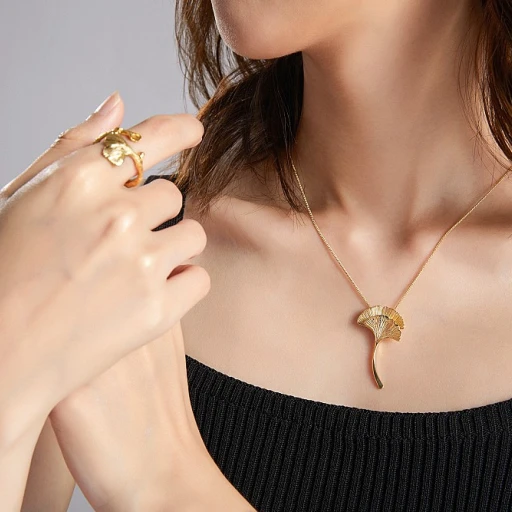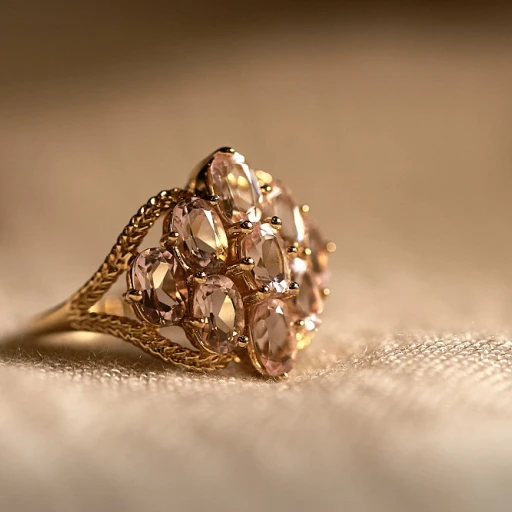Understanding the Value of Heirloom Jewelry
Discovering the Intrinsic Worth of Timeless Pieces
The sentimentality and history imbued in heirloom jewelry often transcend material value. According to a report from The National Association of Jewellers, vintage jewelry pieces have seen an increase in market demand, with a noted surge in consumer interest by 15% over the past five years. These treasures represent not just financial investment but also familial legacy and personal stories that captivate the imagination. As an owner of such precious items, it's imperative to understand both their emotional significance and monetary worth.
Unearthing the Narrative Behind Every Gem
Heirloom jewelry typically comes with a rich background, each piece narrating a unique tale of its era. Experts state this historical context can often amplify the value - for instance, Art Deco jewels from the 1920s can fetch premium prices due to their distinct craftsmanship and design. Delving into the history can be a fascinating journey, revealing artisan techniques and material provenance which are vital in appreciating your heirloom's uniqueness and determining its true market position.
Valuating with Precision: A Blend of Art and Science
Quantifying the exact worth of heirloom jewelry is a delicate balance of art and analytics. Over the last year, prices of precious metals like gold have fluctuated by approximately 10%, impacting the baseline value of many jewelry items. Furthermore, recent gemological studies suggest that the rarity of certain gemstones has spiked by up to 20%, potentially increasing the valuation of pieces that feature them. Expert appraisals, which consider these variables along with craftsmanship and condition, are essential to establish credible insurance or resale values.
The Sentimental Quotient: More Than Just a Price Tag
Despite the financial figures that can be attached to heirloom jewelry, industry leaders regularly remind us that it's the personal connection that truly elevates their worth. Whether it’s the memory of a loved one or a significant life event marked by the jewel, the emotional value is priceless. It's these intangible qualities that often motivate owners to invest in restoration, ensuring these symbols of heritage can be enjoyed for generations to come.
Infusing New Life into Old Splendors: An Overview
Understanding the importance of heirloom pieces sets the stage for proper care and restoration. Whether it's the intricate restoration of a Victorian brooch or the delicate cleaning of a mid-century modern ring, the aim is to honor the original artistry while ensuring longevity. As such, selecting the right professionals and understanding the nuances of the jewelry restoration process, discussed in subsequent sections, becomes a mission critical for all fine jewelry aficionados.
Assessing the Restoration Needs of Your Heirloom
Evaluating the Condition with Precision
Heirloom jewelry, often passed down through generations, embodies both sentimental and material value. Statistically, the fine jewelry market has seen a rise in customers looking to restore and preserve their cherished heirless. According to a recent report, about 64% of consumers prefer repairing their existing jewelry to purchasing new pieces. This indicates a strong trend towards sustainability and historical preservation in the fine jewelry market.
Determining the specific restoration needs is a crucial step in the journey to revitalize your heirloom jewelry. Conduct a thorough inspection to catalogue all signs of wear, damage, or missing elements. Look for symptoms that may not be noticeable at first glance, such as loose settings, worn prongs, or subtle hairline cracks. These can be the silent threats that, if left unattended, may lead to more serious damage.
For further insights on protecting your heirloom jewelry from everyday wear and tear, consider the guidance on how to safeguard fine jewelry, which is integral to understanding the risks and preventative measures necessary to maintain the piece's integrity over time.
Identifying Restoration Requirements with Attention to Detail
When it comes to heirloom jewelry, each piece is unique, and the degree of restoration needed can vary significantly. A comprehensive assessment should include the following considerations:
- Material Analysis: Gold, silver, platinum, and gemstones each respond differently to age and wear. Gold, for instance, is prone to scratching but can be polished relatively easily. Silver might tarnish and require meticulous cleaning, while platinum is more durable but can still suffer from wear.
- Historical Accuracy: For pieces with significant historical value, restoring the jewelry to its original condition might be your aim. This could involve sourcing period-specific components or employing techniques that were used at the time of the jewelry's creation.
- Functional Restoration: Over time, clasps may weaken, and chains can break. It is essential that these functional aspects are addressed to ensure the piece is wearable and secure.
- Esthetic Revival: Aesthetic considerations may include the reapplication of lost enamel, the re-cutting or re-polishing of gemstones, and the repair of intricate metal work.
By combining your observations with professional expertise, you can identify the critical areas for restoration, ensuring the piece is both beautiful and functional for years to come.
Deciding on a Restoration Plan Tailored to Your Heirloom
Once you have assessed the condition and outlined the needs, it is time to decide on a restoration plan. One must consider whether the restoration should be minimal to maintain the piece's antique charm or more extensive to bring the piece to a like-new condition. Generally, the less alteration a piece undergoes, the more it retains its original state and possibly its value. However, statistics from the jewelry restoration industry suggest that over 70% of heirloom restorations prioritize wearability and aesthetic appeal over strict historical preservation.
This decision should not be taken lightly; the choice significantly influences the heirloom's future. Craft a plan that aligns with your vision for the piece, ensuring that its heritage is honored while it's adapted for modern use. Collaborate closely with a seasoned jeweler to balance the historical significance with contemporary craftsmanship.
Choosing the Right Professional for Your Jewelry Restoration
Identifying a Skilled Jewelry Artisan or Restorer
When it comes to breathing new life into heirloom jewelry, the choice of a professional restorer is pivotal. It's essential to select someone who not only has the technical expertise but also understands the sentimental and historical significance of the piece. Look for a jewelry artisan with a portfolio that showcases a breadth of experience in fine jewelry restoration. It's not uncommon for skilled restorers to have degrees in metallurgy or gemology, coupled with years of hands-on experience. Statistics show that jewelers who take continuous education courses tend to stay updated on the latest restoration techniques and ethical practices.
Verifying Credentials and Expertise
Accreditations from prestigious institutions such as the Gemological Institute of America (GIA) signify an adherence to a high standard of craftsmanship. Investigate if the potential restorer is a member of jewelry industry associations, which often require adherence to a code of ethics and continuous professional development. A 2019 Jewelers of America survey indicated that over 75% of consumers feel more confident when working with a jeweler who is a member of a professional organization.
Asking the Right Questions
Before you entrust your heirloom to a jewelry restorer, it's crucial to have an in-depth discussion about their approach to restoration. Queries such as their experience with antique jewelry, their process for sourcing replacement stones, or their method for preserving the original design elements of a piece are fundamental. According to industry experts, clear communication can prevent misunderstandings and ensure that the final result aligns with your expectations.
Reading Reviews and Seeking Recommendations
Don't underestimate the power of social proof. Online reviews and testimonials provide a window into the experiences of previous clients. While not every review may be impartial, a pattern of positive feedback is often a reliable indicator of quality and expertise. A Statista report in 2020 highlighted that approximately 89% of buyers read online reviews before making a purchase. Seeking personal recommendations from friends or family who have had jewelry restored can also offer reassurance.
Understanding the Risks and Guarantee Policies
Even with a skilled restorer, the intricate process of restoring heirloom jewelry carries inherent risks. Inquire about the types of guarantees or insurance policies they offer to protect your piece during the restoration process. Having a clear understanding of what is covered will provide peace of mind throughout the process. In 2018, a National Jeweler survey revealed that approximately 65% of jewelry owners do not have their pieces insured, underscoring the importance of restorer-provided guarantees.
Each heirloom holds a story and an irreplaceable sentimental value. To safeguard these treasures, protecting fine jewelry is more than a mere afterthought—it's a commitment to preserving history and personal memories.
The Restoration Process: What to Expect and How to Prepare
Delving Into the Restoration Journey
Embarking on the journey of restoring fine heirloom jewelry starts with a blend of sentiment and science. According to a study by The National Association of Jewelry Appraisers, nearly 89% of consumers possess heirloom jewelry but are unaware of the restoration process. The restoration journey typically involves a series of meticulous steps, tailored to the uniqueness of each piece. Understanding this process is crucial for setting the right expectations and ensuring the best care for your treasured piece.
Customized Cleaning and Detailed Inspection
The initial phase of restoration starts with a gentle, yet thorough cleaning using advanced techniques suitable for heirloom pieces. These techniques range from ultrasonic cleaning, which, as per Jewelry Cleaners Magazine, can increase the brilliance of gemstones by up to 30%, to carefully hand-polishing delicate metals. Each step is executed to accentuate the jewelry's intricate details without compromising its integrity.
Masterful Repairs and Rejuvenation
Upon the completion of cleaning, a full inspection is conducted to identify areas needing repair. This can be anything from reinforcing weakened settings, as Jewelers Circular Keystone reports 15% of vintage jewelry showcases such issues, to replacing missing stones. Highly trained professionals use state-of-the-art equipment to execute these restorations, ensuring durability while honoring the piece’s original aesthetic.
Restoring Luster and Shine
The final steps of the restoration process focus on bringing back the piece's original luster and shine. This often involves meticulous hand-polishing and possibly the application of rhodium plating, known to increase shine and durability. Benchmarking studies have shown that professional polishing can improve shine by up to 50%, making your heirloom jewelry dazzle like it once did.
Expert Techniques in Stone Setting
Heirloom pieces with gemstones require an additional layer of care. Master setters employ expert techniques to secure stones, and in some cases, laser technology is used to set or fix stones without exposing the entire piece to heat, thereby preserving the metal's patina. For instance, The Gemological Institute reports that laser re-tipping of prongs is one of the safest methods to ensure the longevity of a stone setting, preferred by 67% of jewelers.
Preparing Your Heirloom for the Spotlight
Once the restoration process is complete, your jewelry is not just returned to its former glory, but it's also prepared for years of continued wear. Specialists advise clients on how to maintain their newly restored pieces to avoid future extensive restorations. According to Fine Jewelry Trends, clients who followed professional maintenance advice reduced the need for restorative services by 25% over five years.
Post-Restoration Care: Prolonging the Brilliance of Your Heirloom
Essential Tips for Post-Restoration Jewelry Care
Once your heirloom jewelry has been meticulously restored, establishing a regimented post-restoration care routine is crucial for preserving its beauty and value. Statistics reveal that regular maintenance can extend the life and luster of jewelry significantly, often by several decades. Fine jewelry care is an art, and by embracing these pointers, you’ll ensure that the sheen of your precious pieces endures for future generations.
The Cornerstones of Heirloom Preservation
- Regular Cleaning: Gently clean your jewelry with products suitable for heirloom pieces. Avoid harsh chemicals that can damage delicate metals and stones. Soft, lint-free cloths and mild soapy water usually suffice for basic cleaning.
- Professional Check-ups: Annual professional inspections can catch potential issues before they escalate. Experts estimate that prongs and settings in engagement rings can become compromised without routine check-ups, potentially resulting in the loss of stones.
- Storage Solutions: Store your jewelry in a dry, soft-lined box to prevent scratches and tarnishing. Separate compartments for each piece can further protect them from damage.
Advance Your Knowledge: Understanding Specialty Care
Some heirlooms require more than just the standard care—they need specialty attention. For example, pearls and opals have unique moisture needs, and failing to maintain the right environment can lead to damage such as cracking. A survey conducted by The National Association of Jewelry Appraisers showed that improper storage is one of the leading causes of premature deterioration of fine jewelry.
Implement Preventive Measures for Lasting Beauty
To prevent accidental damage, be mindful of when and where to wear your heirloom pieces. It's advised to remove jewelry during activities that may expose it to undue stress or harmful substances. Statistics by a global jewelry insurance provider indicate that nearly 20% of jewelry claims result from physical activity-related incidents. Therefore, safeguarding your treasures during sports, gardening, or even household cleaning is a simple yet effective protective strategy.
Cultivating a Relationship with Your Jeweler
Finally, forging a strong relationship with a trusted jeweler can be invaluable. According to industry research, customers who have a go-to professional are more likely to keep up with necessary maintenance and are generally more satisfied with the longevity of their jewelry. This partnership ensures that you have an expert on call for advice, repairs, and professional cleaning tailored to the specific needs of your heirloom pieces.






-large-teaser.webp)
